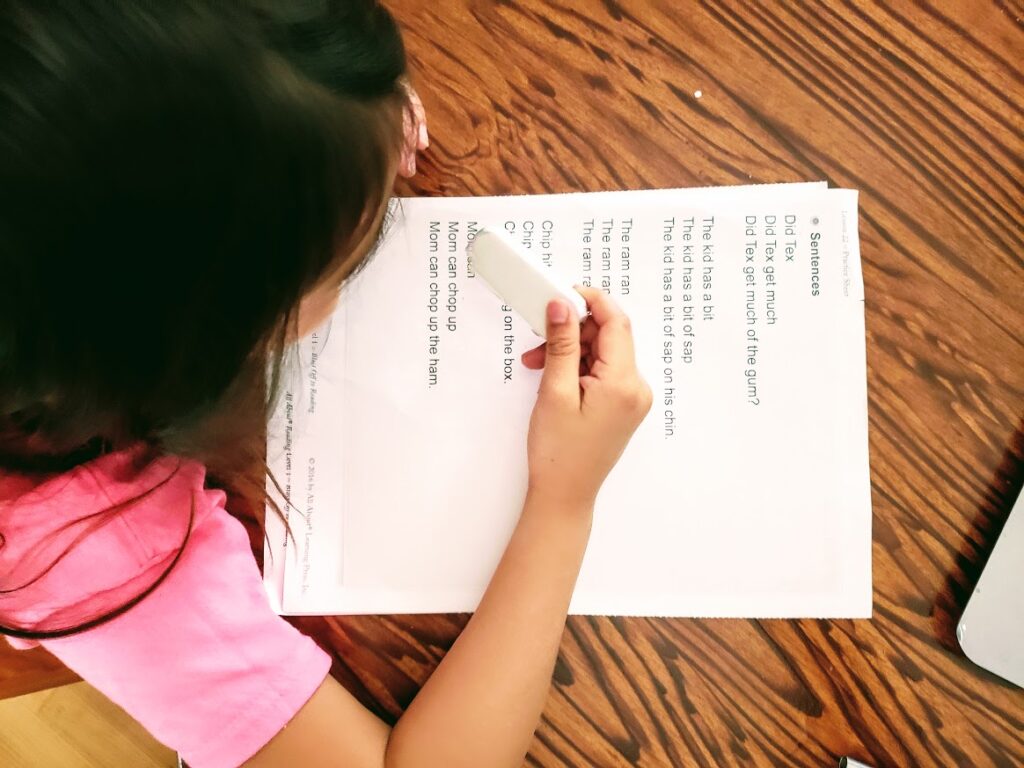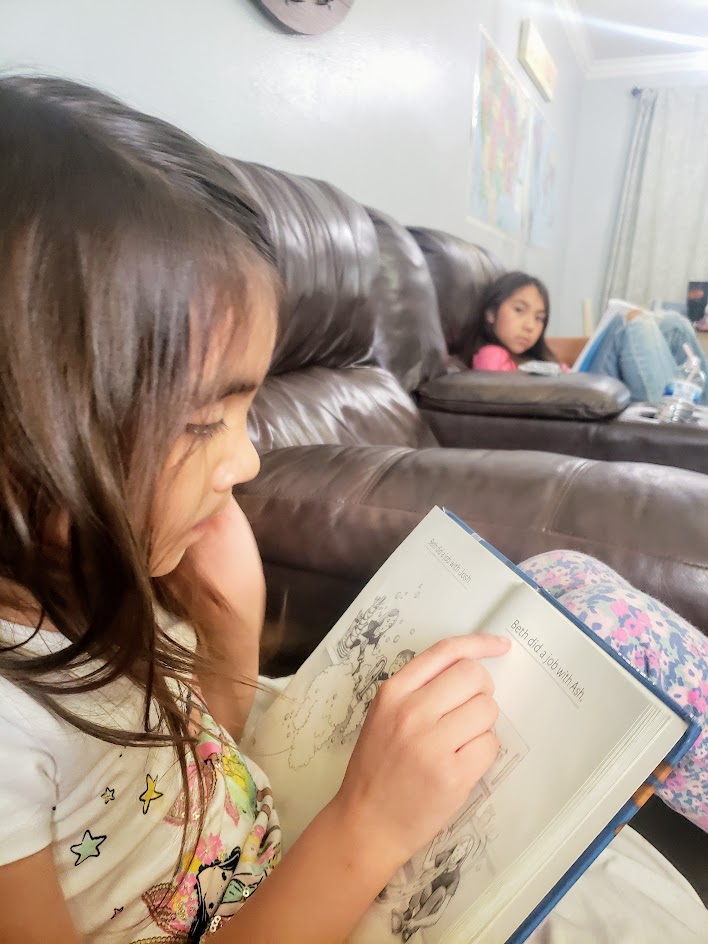
All About Reading Teaching Tips and Help
More Multisensory Practice
All About Reading’s Multisensory approach is one of the amazing components of the program. But as we all know some of our students need a little more. So Lets get into some useful All About Reading Tips. Multisensory is exactly what it sounds like, using all your senses. The tiles are a great component and worked wonderfully for one of my children. My other child needed something more.

Refridgerator Magnets
I needed a way for my daughter to practice letter sounds and this was before she could write her letters very well. I would verbalize the letter sound and she needed to tell me what letter made that sound. We didn’t add writing to this part of our lessons yet because it would have just caused frustration. We should be careful to not hold our children back in everything just because they struggle in one thing. So the letter refrigerator magnets like these here on Amazon were a great addition to our All About Reading program and is a useful teaching tip to add to any program.
Lay out 3-4 letters, dictate a sound and have the child find it. Slowly add more letters to the pile until its the whole bucket and by then they will know exactly what they are looking for.
I would also have my daughter close her eyes, study the letters with her hands and I would tell her the sound for that letter. You can practice a few, 3 or 4 and then reverse it and have the child say what letter they are holding with their eyes closed.
Being able to physically feel the shape of the letters is so helpful in really solidifying letter sounds. Even having them carry a letter that they struggle with in their pocket. Refer to the pocketed letter throughout the day as you both see things that begin or end with that letter.
Write on their back
This is another one that really utilizes the sense of touch. You can use a pen with the top on and write letters on their back, hands, or even arm when practicing letters or even small words.
For higher grades tapping out syllables and new phonograms on their arm is really useful as well.
Use The Games and Suggestions in the Appendix
Alot of people forget about all the awesome teaching tips, suggestions and game ideas that All About Reading provides in their appendixes in the back of the book. They include them in every level all the way up to the last level, level 4.
Games like “Color It” where you find a coloring sheet with big spaces, put letters (or words if you would like) and have the child sound, then color in that section if they get it right. How amazing is that, and they have a ton just like it! All multisensory.
Great suggestions if you need to slow down and review the material again in game form. Even if your ready to move on but want to add a game to your review time.
Spelling and Handwriting
All About Reading teaches reading and spelling separately and for good reason. They explain why here. Often it is a good idea to focus on reading first. Though, in the course of learning to read some students may need a little “more”. This is where I suggest adding in spelling, or encoding to be more precise. The focus should still be on reading but adding that encoding component hits different receptors in their brains. Encoding gets them more familiar with the letters or words.
This is as simple as dictating the cards and practice sheets and have them “sound out”, and write out the words. You will have to walk them through it, a few basic spelling techniques are
- Count the sounds (possibly with something tactile)
- Identify the sounds
- Write the letter(s)
- Child says the sounds of the letters as they write them
All About Spelling goes into much more depth and technique but for the sake of keeping it simple because things often get overcomplicated in the homeschool world this is a good starting point.
Use Different Readers

I am not suggesting adding Bob Books unless you need them. My opinion is the less components the better. With that said if you have already used the curriculum to the fullest and your child needs more practice and doesn’t want to re-read the stories again, Bob Books is your answer. There are very few book series that align with early phonics learning. I did a lot of searching. There are some others but Bob Books are by far the most readily available. You can choose a set that goes along with where your child is at. You can find them here on their website and also on Amazon here.
Extra Practice
Remember your the teacher, even public school teachers go off the script especially if it means solidifying a concept. I have often used an AAR teaching method where the teacher’s manual does not say to do that, but my child needed the practice.
For instance, when AAR introduces a new phonogram and has the child read a string of those words by only changing 1 letter, with the letter tiles. I often use this method in review of phonograms I have already taught but have the child spell it out instead of read it.
This All About Reading teaching tip can literally be used with any section, in any way though.
If The Stories Are Too Long or Difficult
In the lower levels a suggestion you will frequently see is to re-read the stories. I agree with this suggestion since the stories are shorter, Re-reading can build fluency and confidence.
What though in the higher levels when those stories get really long! Many people forget that dyslexia doesn’t go away. Even though you may have made it to the higher levels of All About Reading it may still take a lot out of your child to get through those stories. So don’t be afraid to watch your child’s cues. When they are tired, call it a day, stop there and come back to it tomorrow.
When you come back to the story the next day you can pick up where you left off. Talk about what the first section of the story was about before you begin. You could even re-read the part they have already read to get their minds back into the story and let them take over when it gets to the new part. I know, shocking! Reading for them? Sounds crazy, right?
A lesson I had to learn the hard way is everything does not need to be a test. Building confidence is part of the learning process. A lot of dyslexic children have trouble with memory. How would you like to start reading a book in the middle, frustrated or disinterested right? So re-reading the previous section for them is going to put them in the right mindset wanting to know what comes next.
Word Card (Green Cards) Overload
If the review section gets full we have all questioned what to do. The word cards are the next step in solidifying the new phongram but in real life words. So if your child is easily recognizing and saying all the sounds of the word, and quickly putting those sounds together into the correct word then they are doing exactly what they are supposed to be doing. What you may be looking for is fluency which will come more from reading the stories, and hearing you read. All About Reading has this great article on their blog about improving fluency.
Often it takes awhile for these kids to gain fluency. So we keep those word cards in the review section and they pile up. I suggest focusing on a smaller amount of words if you really want them to remember the actual word. It could be 5 or it could be 15. You have to decide because only you know your child. Just like we would hyperfocus on a letter our child was having trouble with we should do the same with the words. Give them a doable amount.
If your like me and arent too concerned on the word but more focused on getting the actual phonogram down itself its a good idea to pick a few word cards from each phonogram so they can practice them all without having a giant stack. The phonogram needs too be practiced itself, inside a word, inside a sentence, and so on.
Move on
My last All About Reading teaching tip might be unpopular or hard to do but sometimes its just time to move on to the next lesson. I used to always want my daughter to master the new concept perfectly before moving on but it almost never worked out that way. We kept chuggin’ along and my daughter didn’t have true fluency until level 3! I distinctly remember this because all the moms in the Facebook homeschool groups would say how their child’s reading would take off in level 2 and that just didn’t happen for her.
It was scary not knowing what to do but as long as my daughter understood (not necessarily master) the new teaching we just kept moving. Yes I would have to remind her of things she had already learned all the time but I think that’s what really helped! Me reminding her of a phonogram or a rule in the moment she was reading a word that was significant in a story that interested her. Yes that meant I was her human information holder but that’s ok. It was so worth it and she took over holding that information for herself after using these things in real life over and over.
I know its hard momma, and scary sometimes. But you and your babies can do this together. Have patience, know they are doing their best, and tell yourself with confidence that they will get there. I hope so much any of these things have helped you. Comment down below and tell me how you made All About Reading work for you and your kiddo. What did you do that was off script?
Also don’t forget to come visit us at our Instagram to see what we are doing daily. And remember these are the good old day so follow those rabbit trails and have fun, you never know where you might end up.